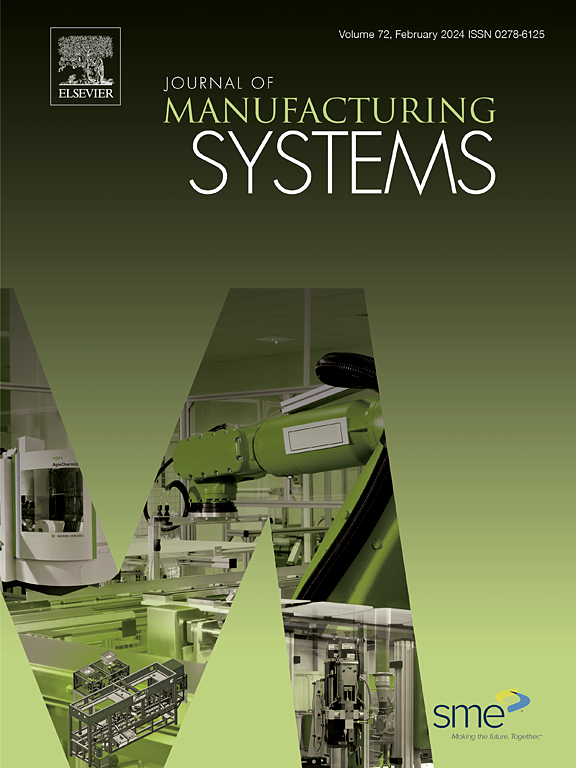An intelligent monitoring system for robotic milling process based on transfer learning and digital twin
IF 12.2
1区 工程技术
Q1 ENGINEERING, INDUSTRIAL
引用次数: 0
Abstract
Robotic milling is becoming widely used in aerospace and auto manufacturing due to its high flexibility and strong adaptability. However, the practical challenges including complex and time-consuming robot trajectory planning, insufficient monitoring, and lacking three-dimensional visualization limits its further application. To address these challenges, an intelligent monitoring system for robotic milling process based on transfer learning and digital twin was proposed and developed in this paper. Firstly, the fundamental framework of this system was conducted based on a five-dimensional digital twin model for motion simulation, visualization, and tool wear prediction during the robotic milling process. Secondly, the parsing algorithm converting NC code to robot’s machining trajectory and material removal algorithm based on bounding box and mesh deformation were proposed for robotic dynamic milling simulation. Thirdly, a novel transfer learning algorithm named CNN-LSTM-TrAdaBoost.R2 was developed by integrating CNN-LSTM with TrAdaBoost.R2 for automated feature extraction and real-time prediction of tool wear. Finally, the effective and accuracy of tool wear prediction algorithm is verified by ablation experiment and the robotic milling simulation is validated by real milling experiment, as well. The results indicate that the proposed monitoring system for robotic milling process demonstrates great virtual-real mapping. It can offer new insights and technical support for constructing sophisticated digital twin frameworks and enhancing operational monitoring in manufacturing systems.
基于迁移学习和数字孪生的机器人铣削过程智能监控系统
机器人铣削以其高灵活性和强适应性在航空航天和汽车制造业中得到广泛应用。然而,机器人轨迹规划复杂耗时、监测不足、缺乏三维可视化等现实挑战限制了其进一步应用。针对这些挑战,本文提出并开发了一种基于迁移学习和数字孪生的机器人铣削过程智能监控系统。首先,基于五维数字孪生模型构建了该系统的基本框架,用于机器人铣削过程的运动仿真、可视化和刀具磨损预测。其次,针对机器人动态铣削仿真,提出了将NC代码转换为机器人加工轨迹的解析算法和基于边界盒和网格变形的材料去除算法;第三,提出了一种新的迁移学习算法CNN-LSTM-TrAdaBoost。R2是通过整合CNN-LSTM和TrAdaBoost开发的。R2用于自动特征提取和实时预测刀具磨损。最后,通过烧蚀实验验证了刀具磨损预测算法的有效性和准确性,并通过实际铣削实验验证了机器人铣削仿真。结果表明,所提出的机器人铣削过程监控系统具有较好的虚实映射效果。它可以为构建复杂的数字孪生框架和增强制造系统的运行监控提供新的见解和技术支持。
本文章由计算机程序翻译,如有差异,请以英文原文为准。
求助全文
约1分钟内获得全文
求助全文
来源期刊

Journal of Manufacturing Systems
工程技术-工程:工业
CiteScore
23.30
自引率
13.20%
发文量
216
审稿时长
25 days
期刊介绍:
The Journal of Manufacturing Systems is dedicated to showcasing cutting-edge fundamental and applied research in manufacturing at the systems level. Encompassing products, equipment, people, information, control, and support functions, manufacturing systems play a pivotal role in the economical and competitive development, production, delivery, and total lifecycle of products, meeting market and societal needs.
With a commitment to publishing archival scholarly literature, the journal strives to advance the state of the art in manufacturing systems and foster innovation in crafting efficient, robust, and sustainable manufacturing systems. The focus extends from equipment-level considerations to the broader scope of the extended enterprise. The Journal welcomes research addressing challenges across various scales, including nano, micro, and macro-scale manufacturing, and spanning diverse sectors such as aerospace, automotive, energy, and medical device manufacturing.
 求助内容:
求助内容: 应助结果提醒方式:
应助结果提醒方式:


